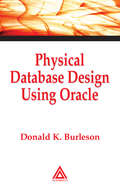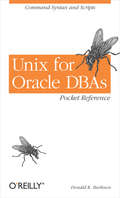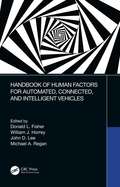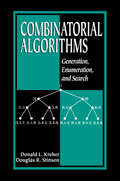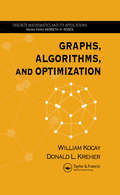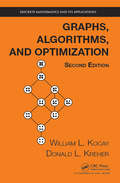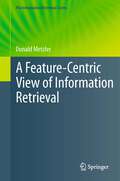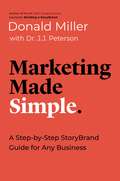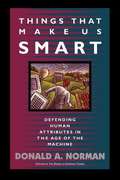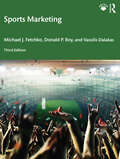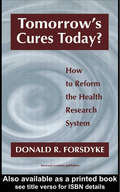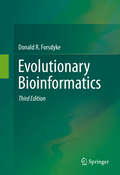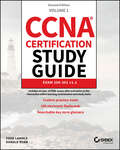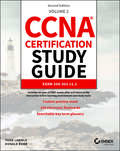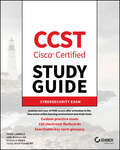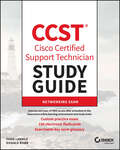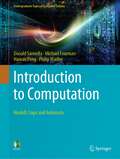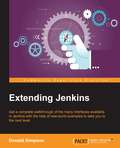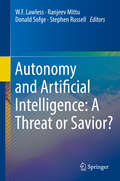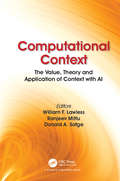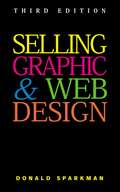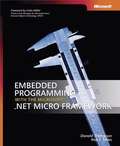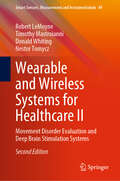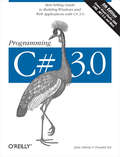- Table View
- List View
Physical Database Design Using Oracle (Foundations Of Database Design Ser.)
by Donald K. BurlesonThe evolution of Oracle has led to a revolution in design practices. For Oracle 10g, database physical structures have become more complex than ever before and database designers face multiple ways to implement their logical models. IS students studying database design and administration need to be able to implement management systems in a way that
Unix for Oracle DBAs Pocket Reference: Command Syntax and Scripts
by Donald K. BurlesonThe Unix for Oracle DBAs Pocket Reference puts within easy reach the commands that Oracle database administrators need most when operating in a Unix environment. If you are an Oracle DBA moving to Unix from another environment such as Windows NT or IBM Mainframe, you know that these commands are far different from those covered in most beginning Unix books. To jump start your learning process, Don Burleson has gathered together in this succinct book the Unix commands he most often uses when managing Oracle databases. You'll be able to reach into your pocket for the answer when you need to know how to:Display all Unix components related to Oracle, identify the top CPU consumers on your server, and even kill processes when necessaryStack Unix commands into powerful scripts that can perform vital DBA functionsMonitor Unix filesystems, and automatically manage your trace files, dump files, and archived redo log filesUse essential server monitoring commands such as top, sar, and vmstatAnd there's much more between these covers. If you need to get up to speed with Oracle on Unix, and quickly, this book is for you.
Handbook of Human Factors for Automated, Connected, and Intelligent Vehicles
by John D. Lee Michael A. Regan Donald L. Fisher William J. HorreyHandbook of Human Factors for Automated, Connected, and Intelligent Vehicles Subject Guide: Ergonomics & Human Factors Automobile crashes are the seventh leading cause of death worldwide, resulting in over 1.25 million deaths yearly. Automated, connected, and intelligent vehicles have the potential to reduce crashes significantly, while also reducing congestion, carbon emissions, and increasing accessibility. However, the transition could take decades. This new handbook serves a diverse community of stakeholders, including human factors researchers, transportation engineers, regulatory agencies, automobile manufacturers, fleet operators, driving instructors, vulnerable road users, and special populations. It provides information about the human driver, other road users, and human–automation interaction in a single, integrated compendium in order to ensure that automated, connected, and intelligent vehicles reach their full potential. Features Addresses four major transportation challenges—crashes, congestion, carbon emissions, and accessibility—from a human factors perspective Discusses the role of the human operator relevant to the design, regulation, and evaluation of automated, connected, and intelligent vehicles Offers a broad treatment of the critical issues and technological advances for the designing of transportation systems with the driver in mind Presents an understanding of the human factors issues that are central to the public acceptance of these automated, connected, and intelligent vehicles Leverages lessons from other domains in understanding human interactions with automation Sets the stage for future research by defining the space of unexplored questions
Combinatorial Algorithms: Generation, Enumeration, and Search (Discrete Mathematics And Its Applications Ser. #7)
by Donald L. Kreher Douglas R. StinsonThis textbook thoroughly outlines combinatorial algorithms for generation, enumeration, and search. Topics include backtracking and heuristic search methods applied to various combinatorial structures, such as:CombinationsPermutationsGraphsDesignsMany classical areas are covered as well as new research topics not included in most existing texts, such as:Group algorithmsGraph isomorphismHill-climbingHeuristic search algorithmsThis work serves as an exceptional textbook for a modern course in combinatorial algorithms, providing a unified and focused collection of recent topics of interest in the area. The authors, synthesizing material that can only be found scattered through many different sources, introduce the most important combinatorial algorithmic techniques - thus creating an accessible, comprehensive text that students of mathematics, electrical engineering, and computer science can understand without needing a prior course on combinatorics.
Graphs, Algorithms, and Optimization (Discrete Mathematics and Its Applications)
by William Kocay Donald L. Kreher<p>Graph theory offers a rich source of problems and techniques for programming and data structure development, as well as for understanding computing theory, including NP-Completeness and polynomial reduction. A comprehensive text, Graphs, Algorithms, and Optimization features clear exposition on modern algorithmic graph theory presented in a rigorous yet approachable way. The book covers major areas of graph theory including discrete optimization and its connection to graph algorithms. The authors explore surface topology from an intuitive point of view and include detailed discussions on linear programming that emphasize graph theory problems useful in mathematics and computer science. Many algorithms are provided along with the data structure needed to program the algorithms efficiently. <p>The book also provides coverage on algorithm complexity and efficiency, NP-completeness, linear optimization, and linear programming and its relationship to graph algorithms.Written in an accessible and informal style, this work covers nearly all areas of graph theory. Graphs, Algorithms, and Optimization provides a modern discussion of graph theory applicable to mathematics, computer science, and crossover applications.</p>
Graphs, Algorithms, and Optimization (Discrete Mathematics and Its Applications)
by William Kocay Donald L. KreherThe second edition of this popular book presents the theory of graphs from an algorithmic viewpoint. The authors present the graph theory in a rigorous, but informal style and cover most of the main areas of graph theory. The ideas of surface topology are presented from an intuitive point of view. We have also included a discussion on linear programming that emphasizes problems in graph theory. The text is suitable for students in computer science or mathematics programs.
A Feature-Centric View of Information Retrieval (The Information Retrieval Series #27)
by Donald MetzlerCommercial Web search engines such as Google, Yahoo, and Bing are used every day by millions of people across the globe. With their ever-growing refinement and usage, it has become increasingly difficult for academic researchers to keep up with the collection sizes and other critical research issues related to Web search, which has created a divide between the information retrieval research being done within academia and industry. Such large collections pose a new set of challenges for information retrieval researchers. In this work, Metzler describes highly effective information retrieval models for both smaller, classical data sets, and larger Web collections. In a shift away from heuristic, hand-tuned ranking functions and complex probabilistic models, he presents feature-based retrieval models. The Markov random field model he details goes beyond the traditional yet ill-suited bag of words assumption in two ways. First, the model can easily exploit various types of dependencies that exist between query terms, eliminating the term independence assumption that often accompanies bag of words models. Second, arbitrary textual or non-textual features can be used within the model. As he shows, combining term dependencies and arbitrary features results in a very robust, powerful retrieval model. In addition, he describes several extensions, such as an automatic feature selection algorithm and a query expansion framework. The resulting model and extensions provide a flexible framework for highly effective retrieval across a wide range of tasks and data sets. A Feature-Centric View of Information Retrieval provides graduate students, as well as academic and industrial researchers in the fields of information retrieval and Web search with a modern perspective on information retrieval modeling and Web searches.
Marketing Made Simple: A Step-by-Step StoryBrand Guide for Any Business
by Donald Miller Dr. J.J. PetersonBased on Building a StoryBrand by New York Times bestselling author Donald Miller, this checklist is a strategic and actionable guide to applying the StoryBrand framework to any brand and an essential part of any marketing professional&’s tool kit.Every day, brands lose millions of dollars simply because they do not have a clear message that tells consumers who they are and what value they will add to their customers&’ lives. To solve this dilemma, Donald Miller wrote Building a StoryBrand, which has become the quintessential guide for anyone looking to craft or strengthen their brand&’s message.Now, Don is taking it a step further with this five-part checklist that helps marketing professionals and business owners apply the StoryBrand messaging framework across key customer touchpoints to effectively develop, strengthen, and communicate their brand&’s story to the marketplace.Praise for Marketing Made Simple"I created collateral for a client and they recently told me not to release the next round we created because they can&’t handle the influx of customers from the first round. They had more listings this year than in 30 years of business." - Amy Burgess, Marketing Consultant"My last email campaign I delivered raised $20k. Thank you Donald Miller for giving me a system that I know works." - Ian Stewart, Owner/Creative Director of Root Source Digital"A client went from $15MM last year to $27MM so far this year. All from updating their messaging and implementing new lead generators and email campaigns.- Wes Gay, CEO Wayfinder"Just heard from one of my clients that she&’s getting 18 ideal client leads a day from her website. Before we redid her wireframe, she averaged around 1-3 leads a week. And that&’s just with updating her website." - Amy Schutte, Owner of Hudson and Co LLC
Things That Make Us Smart: Defending Human Attributes in the Age of the Machine
by Donald NormanHumans have always worked with objects to extend our cognitive powers, from counting on our fingers to designing massive supercomputers. But advanced technology does more than merely assist with thought and memory.
Sports Marketing
by Donald P. Roy Michael J. Fetchko Vassilis DalakasHighly practical and engaging, Sports Marketing equips students with the skills, techniques, and tools they need to be successful marketers in any sporting environment. The book blends relevant marketing theory—focusing on industry-specific terminology and practices—with practitioner insights into current issues and future directions in the sports industry. This anticipated third edition has been fully updated to incorporate a broad range of global and diverse perspectives from industry experts and international case studies throughout. Contemporary topics within the sports industry have been expanded upon, including esports, social responsibility, sustainability, digital and social media, and personal branding. Popular "You Make the Call" cases, insider and early career insights, and review questions stimulate lively classroom discussion, while chapter summaries and terms support further support learning. Overall, this exciting text will: • Increase students’ depth of knowledge about sports marketing • Challenge students to apply concepts to real-world situations • Profile best practices of organizations and individuals within the sports industry as they relate to the book’s content • Equip students to position themselves to compete for entry-level positions in sports business • Provide faculty with a concise but thorough text that meets their needs. Sports Marketing remains a core textbook for undergraduate and postgraduate students of sports marketing and management, providing a firm grasp of the ins and outs of working in sports. Additional online resources include PowerPoint slides for each chapter, a test bank of questions, and an instructor’s manual.
Tomorrow's Cures Today?: How to Reform the Health Research System
by Donald R ForsdykeDiscussing the laws in the current research funding decision process, the author suggests ways to improve future funding of health research systems. Chapters recount ways of raising funds, the tragic way authorities improperly introduced diptheria immunization, consideration of how the peer review system evolved in response to massive infusion of f
Evolutionary Bioinformatics
by Donald R. ForsdykeNow in its third edition and supplemented with more online material, this book aims to make the "new" information-based (rather than gene-based) bioinformatics intelligible both to the "bio" people and the "info" people. Books on bioinformatics have traditionally served gene-hunters, and biologists who wish to construct family trees showing tidy lines of descent. While dealing extensively with the exciting topics of gene discovery and database-searching, such books have hardly considered genomes as information channels through which multiple forms and levels of information have passed through the generations. This "new bioinformatics" contrasts with the "old" gene-based bioinformatics that so preoccupies previous texts. Forms of information that we are familiar with (mental, textual) are related to forms with which we are less familiar (hereditary). The book extends a line of evolutionary thought that leads from the nineteenth century (Darwin, Butler, Romanes, Bateson), through the twentieth (Goldschmidt, White), and into the twenty first (the final works of the late Stephen Jay Gould). Long an area of controversy, diverging views may now be reconciled.
CCNA Certification Study Guide Volume 1: Exam 200-301 v1.1 (Sybex Study Guide)
by Todd Lammle Donald RobbYour comprehensive guide to succeeding on the UPDATED CCNA Certification exam In the newly revised second edition of the CCNA Certification Study Guide Volume 1: Exam 200-301 v1.1, celebrated Cisco educator and network guru Todd Lammle and expert Donald Robb deliver an intuitive and efficient roadmap to the challenging CCNA Certification test. The updated Study Guide covers many topics, including network fundamentals and access, IP connectivity and services, security fundamentals, automation, programmability, artificial intelligence, and more. The CCNA Certification Study Guide comes with complementary access to a robust set of online study tools designed to assess and advance your exam readiness. You'll find: Up-to-date information relevant to the latest Cisco technologies and job roles An interactive online test bank, including hundreds of practice test questions, flashcards, and a glossary of key terms and definitions Discussions of everything from VLANs and Inter-VLAN Routing to switching, OSPF, IP routing, and more Perfect for anyone preparing to pursue the updated CCNA Certification, the CCNA Certification Study Guide Volume 1: Exam 200-301 v1.1, Second Editon, is a must-read for practicing IT professionals looking for a refresher on Cisco networking fundamentals.
CCNA Certification Study Guide Volume 2: Exam 200-301 v1.1 (Sybex Study Guide)
by Todd Lammle Donald RobbYour updated guide to success on the CCNA Certification exam In the newly revised second edition of the CCNA Certification Study Guide – Volume 2: Exam 200-301 v1.1, renowned Cisco educator and network engineer Todd Lammle and Donald Robb deliver a practical and effective test prep and roadmap to the challenging CCNA Certification exam. Volume 2 of the updated Study Guide covers objectives for network fundamentals and access, IP connectivity and services, security fundamentals, automation, programmability, artificial intelligence, and more. You'll also learn about topics like network device security, IPv6, QoS, wireless technologies, wireless controllers, automation, and REST APIs. The CCNA Certification Study Guide comes with one year of free access after activation to a robust set of online study tools designed to assess and advance your exam readiness. You'll find: Up-to-date information relevant to the latest Cisco technologies and job roles An interactive online test bank, including hundreds of practice test questions, flashcards, and a glossary of key terms and definitions Discussions of everything from enhanced switching and ACLs to FHRP, SDN, configuration management, and more Perfect for anyone preparing to pursue the updated CCNA Certification, the CCNA Certification Study Guide – Volume 2 is a must-read for practicing IT professionals looking for a refresher on Cisco networking fundamentals.
CCST Cisco Certified Support Technician Study Guide: Cybersecurity Exam (Sybex Study Guide)
by Todd Lammle Todd Montgomery Jon Buhagiar Donald RobbThe ideal prep guide for earning your CCST Cybersecurity certification CCST Cisco Certified Support Technician Study Guide: Cybersecurity Exam is the perfect way to study for your certification as you prepare to start or upskill your IT career. Written by industry expert and Cisco guru Todd Lammle, this Sybex Study Guide uses the trusted Sybex approach, providing 100% coverage of CCST Cybersecurity exam objectives. You’ll find detailed information and examples for must-know Cisco cybersecurity topics, as well as practical insights drawn from real-world scenarios. This study guide provides authoritative coverage of key exam topics, including essential security principles, basic network security concepts, endpoint security concepts, vulnerability assessment and risk management, and incident handling. You also get one year of FREE access to a robust set of online learning tools, including a test bank with hundreds of questions, a practice exam, a set of flashcards, and a glossary of important terminology. The CCST Cybersecurity certification is an entry point into the Cisco certification program, and a pathway to the higher-level CyberOps. It’s a great place to start as you build a rewarding IT career! Study 100% of the topics covered on the Cisco CCST Cybersecurity certification exam Get access to flashcards, practice questions, and more great resources online Master difficult concepts with real-world examples and clear explanations Learn about the career paths you can follow and what comes next after the CCSTThis Sybex study guide is perfect for anyone wanting to earn their CCST Cybersecurity certification, including entry-level cybersecurity technicians, IT students, interns, and IT professionals.
CCST Cisco Certified Support Technician Study Guide: Networking Exam
by Todd Lammle Donald RobbThe ideal prep guide for earning your CCST Networking certification CCST Cisco Certified Support Technician Study Guide: Networking Exam is the perfect way to study for your certification as you prepare to start or upskill your IT career. Written by industry expert and Cisco networking guru Todd Lammle, this Sybex Study Guide uses the trusted Sybex approach, providing 100% coverage of CCST Networking exam objectives. You’ll find detailed information and examples for must-know Cisco networking topics, as well as practical insights drawn from real-world scenarios. This Study Guide provides authoritative coverage of key exam topics, including standards and concepts, addressing and subnet formats, endpoints and media types, infrastructure, diagnosing problems, and security. You also get one year of FREE access to a robust set of online learning tools, including a test bank with hundreds of questions, a practice exam, a set of flashcards, and a glossary of important terminology. The CCST Networking certification is an entry point into the Cisco certification program, and a pathway to the higher-level CCNA, so it’s a great place to start as you build a rewarding career! Study 100% of the topics covered on the Cisco CCST Networking certification exam Get access to flashcards, practice questions, and more great resources online Master difficult concepts with real-world examples and clear explanations Learn about the career paths you can follow and what comes next after the CCSTThis Sybex study guide is perfect for anyone wanting to earn their CCST Networking certification, including entry-level network technicians, networking students, interns, and IT professionals.
Introduction to Computation: Haskell, Logic and Automata (Undergraduate Topics in Computer Science)
by Philip Wadler Donald Sannella Michael Fourman Haoran PengComputation, itself a form of calculation, incorporates steps that include arithmetical and non-arithmetical (logical) steps following a specific set of rules (an algorithm). This uniquely accessible textbook introduces students using a very distinctive approach, quite rapidly leading them into essential topics with sufficient depth, yet in a highly intuitive manner. From core elements like sets, types, Venn diagrams and logic, to patterns of reasoning, calculus, recursion and expression trees, the book spans the breadth of key concepts and methods that will enable students to readily progress with their studies in Computer Science.
Extending Jenkins
by Donald SimpsonGet a complete walkthrough of the many interfaces available in Jenkins with the help of real-world examples to take you to the next level with Jenkins About This Book * Find out how to interact with Jenkins from within Eclipse, NetBeans, and IntelliJ IDEA * Develop custom solutions that act upon Jenkins information in real time * A step-by-step, practical guide to help you learn about extension points in existing plugins and how to build your own plugin Who This Book Is For This book is aimed primarily at developers and administrators who are interested in taking their interaction and usage of Jenkins to the next level. The book assumes you have a working knowledge of Jenkins and programming in general, and an interest in learning about the different approaches to customizing and extending Jenkins so it fits your requirements and your environment perfectly. What You Will Learn * Retrieve and act upon Jenkins information in real time * Find out how to interact with Jenkins through a variety of IDEs * Develop your own Form and Input validation and customization * Explore how Extension points work, and develop your own Jenkins plugin * See how to use the Jenkins API and command-line interface * Get to know how to remotely update your Jenkins configuration * Design and develop your own Information Radiator * Discover how Jenkins customization can help improve quality and reduce costs In Detail Jenkins CI is the leading open source continuous integration server. It is written in Java and has a wealth of plugins to support the building and testing of virtually any project. Jenkins supports multiple Software Configuration Management tools such as Git, Subversion, and Mercurial. This book explores and explains the many extension points and customizations that Jenkins offers its users, and teaches you how to develop your own Jenkins extensions and plugins. First, you will learn how to adapt Jenkins and leverage its abilities to empower DevOps, Continuous Integration, Continuous Deployment, and Agile projects. Next, you will find out how to reduce the cost of modern software development, increase the quality of deliveries, and thereby reduce the time to market. We will also teach you how to create your own custom plugins using Extension points. Finally, we will show you how to combine everything you learned over the course of the book into one real-world scenario. Style and approach Extending Jenkins explores and explains advanced Jenkins functionality from a practical point of view, teaching you real-world skills that will help you get more from this powerful software. Each key topic is explained clearly with a practical example, and in sufficient detail so you understand the concepts and can then develop your own solutions using your preferred software and languages.
Autonomy and Artificial Intelligence: A Threat or Savior?
by Stephen Russell Ranjeev Mittu Donald Sofge W. F. LawlessThis book explores how Artificial Intelligence (AI), by leading to an increase in the autonomy of machines and robots, is offering opportunities for an expanded but uncertain impact on society by humans, machines, and robots. To help readers better understand the relationships between AI, autonomy, humans and machines that will help society reduce human errors in the use of advanced technologies (e.g., airplanes, trains, cars), this edited volume presents a wide selection of the underlying theories, computational models, experimental methods, and field applications. While other literature deals with these topics individually, this book unifies the fields of autonomy and AI, framing them in the broader context of effective integration for human-autonomous machine and robotic systems. The contributions, written by world-class researchers and scientists, elaborate on key research topics at the heart of effective human-machine-robot-systems integration. These topics include, for example, computational support for intelligence analyses; the challenge of verifying today’s and future autonomous systems; comparisons between today’s machines and autism; implications of human information interaction on artificial intelligence and errors; systems that reason; the autonomy of machines, robots, buildings; and hybrid teams, where hybrid reflects arbitrary combinations of humans, machines and robots. The contributors span the field of autonomous systems research, ranging from industry and academia to government. Given the broad diversity of the research in this book, the editors strove to thoroughly examine the challenges and trends of systems that implement and exhibit AI; the social implications of present and future systems made autonomous with AI; systems with AI seeking to develop trusted relationships among humans, machines, and robots; and the effective human systems integration that must result for trust in these new systems and their applications to increase and to be sustained.
Computational Context: The Value, Theory and Application of Context with AI
by Ranjeev Mittu Donald Sofge William F. LawlessThis volume addresses context from three comprehensive perspectives: first, its importance, the issues surrounding context, and its value in the laboratory and the field; second, the theory guiding the AI used to model its context; and third, its applications in the field (e.g., decision-making). This breadth poses a challenge. The book analyzes how the environment (context) influences human perception, cognition and action. While current books approach context narrowly, the major contribution of this book is to provide an in-depth review over a broad range of topics for a computational context no matter its breadth. The volume outlines numerous strategies and techniques from world-class scientists who have adapted their research to solve different problems with AI, in difficult environments and complex domains to address the many computational challenges posed by context. Context can be clear, uncertain or an illusion. Clear contexts: A father praising his child; a trip to the post office to buy stamps; a policewoman asking for identification. Uncertain contexts: A sneak attack; a surprise witness in a courtroom; a shout of "Fire! Fire!" Contexts as illusion: Humans fall prey to illusions that machines do not (Adelson’s checkerboard illusion versus a photometer). Determining context is not easy when disagreement exists, interpretations vary, or uncertainty reigns. Physicists like Einstein (relativity), Bekenstein (holographs) and Rovelli (universe) have written that reality is not what we commonly believe. Even outside of awareness, individuals act differently whether alone or in teams. Can computational context with AI adapt to clear and uncertain contexts, to change over time, and to individuals, machines or robots as well as to teams? If a program automatically "knows" the context that improves performance or decisions, does it matter whether context is clear, uncertain or illusory? Written and edited by world class leaders from across the field of autonomous systems research, this volume carefully considers the computational systems being constructed to determine context for individual agents or teams, the challenges they face, and the advances they expect for the science of context.
Selling Graphic and Web Design
by Donald SparkmanExpert guidance on selling graphic design, in print and online. Attract today's savvy design clients! A veteran designer who turned his small business into a multimillion-dollar new-media company shares his strategies for success in this new edition of the acclaimed Selling Graphic and Web Design. Donald Sparkman's approach blurs the lines between graphic design, web design, and marketing by building strategic partnerships and thinking outside the box. No-nonsense advice for writing proposals and offering the right design solutions, plus information on providing services that fit a client's needs and budget, have made this book indispensable. Now, in this revised and expanded version, leading Internet designers share strategies on effective marketing for the web, including pricing, billing, portfolios, ethics, brand design, web content management, brand law, and much more. Trusted advice and the latest strategies combine to make Selling Graphic and Web Design a great one-stop resource for designers in every field. New edition of a classic Up-to-the-minute advice on selling to internet clients Get the top clients and keep them
Embedded Programming with the Microsoft® .NET Micro Framework
by Rob Miles Donald ThompsonGet the information you need for programming applications in the rich, managed-code environment of the Microsoft .NET Micro Framework. You'll learn how to extend your experience with the .NET Framework and Microsoft Visual C# through real-world examples, expert insights, and code samples--and efficiently build robust applications for the smallest devices. Discover how to: Use an object-oriented approach for programming embedded devices Create input and output port objects Develop detailed text and graphical displays that support complex user interactions Add Windows SideShow functionality into your application Implement functionality from existing applications to embedded applications Bind physical hardware events to Windows Presentation Foundation elements Establish embedded-network connections using TCP/IP Use emulation techniques for rapid-prototyping, experimentation, testing, and debugging Optimize performance of resource-constrained devices PLUS--Get code samples in Visual C# on the Web
Wearable and Wireless Systems for Healthcare II: Movement Disorder Evaluation and Deep Brain Stimulation Systems (Smart Sensors, Measurement and Instrumentation #49)
by Timothy Mastroianni Robert LeMoyne Donald Whiting Nestor TomyczThis book is the second edition of the one originally published in 2019. The original publication features the discovery of numerous novel applications for the use of smartphones and portable media devices for the quantification of deep brain stimulation for the treatment of movement disorders that constitute first-in-the-world applications for these devices. Since the first edition, numerous evolutions involving the domain of wearable and wireless systems for healthcare and deep brain stimulation have transpired warranting the publication of the second edition. This volume covers wearable and wireless systems for healthcare that are far more relevant to the unique requirements of the domain of deep brain stimulation. The paradigm-shifting new wearables comprising attributes of conformability and further miniaturization have been recently applied for the context of deep brain stimulation. Additionally, the subjects of automated optimization for deep brain stimulation and the rampantly expanding additional applications for deep brain stimulation are addressed. The authors expect that these significant developments make this book valuable for all readers.
Programming C# 3.0
by Jesse Liberty Donald XieWritten by popular author and .NET expert Jesse Liberty, this thoroughly updated tutorial for beginning to intermediate programmers covers the latest release of Microsoft's popular C# language (C# 3.0) and the newest .NET platform for developing Windows and web applications. Our bestselling Programming C# 3.0, now in its fifth edition, is a world-class tutorial that goes well beyond the documentation otherwise available. Liberty doesn't just teach C#; he tells the complete story of the C# language and how it integrates with all of .NET programming, so that you can get started creating professional quality web and Windows applications. This book:Provides a comprehensive tutorial in C# and .NET programming that also serves as a useful reference you'll want by your side while you're working Covers all of the new features of the language, thoroughly integrated into every chapter, rather than tacked on at the end Provides insight into best practices and insight into real world programming by a professional programmer who worked with C# as an independent contractor for nearly a decade before joining Microsoft as a Senior Program Manager Every chapter in this book has been totally revised, and the entire book has been reorganized to respond to the significant changes in the language Full coverage, from the ground up of LINQ (Language Integrated Query) and other C# 3.0 language innovations to speed up development tasks Explains how to use C# in creating Web Applications as well as Windows Applications, using both the new Windows Presentation Foundation (WPF) and the older WinForms technology This new edition of Programming C# 3.0 is for working programmers who want to develop proficiency in Microsoft's most important language. No prior .NET experience is required for you to get started. There's no time like the present to work with C# -- and no book like this one to teach you everything you need to know. Special note to VB6 and Java programmers: if you've decided to transition to .NET, this book will take you there.
Programming C# 3.0, 5th Edition
by Jesse Liberty Donald XieWritten by popular author and .NET expert Jesse Liberty, this thoroughly updated tutorial for beginning to intermediate programmers covers the latest release of Microsoft's popular C# language (C# 3.0) and the newest .NET platform for developing Windows and web applications.Our bestselling Programming C# 3.0, now in its fifth edition, is a world-class tutorial that goes well beyond the documentation otherwise available. Liberty doesn't just teach C#; he tells the complete story of the C# language and how it integrates with all of .NET programming, so that you can get started creating professional quality web and Windows applications.This book:Provides a comprehensive tutorial in C# and .NET programming that also serves as a useful reference you'll want by your side while you're workingCovers all of the new features of the language, thoroughly integrated into every chapter, rather than tacked on at the endProvides insight into best practices and insight into real world programming by a professional programmer who worked with C# as an independent contractor for nearly a decade before joining Microsoft as a Senior Program ManagerEvery chapter in this book has been totally revised, and the entire book has been reorganized to respond to the significant changes in the languageFull coverage, from the ground up of LINQ (Language Integrated Query) and other C# 3.0 language innovations to speed up development tasksExplains how to use C# in creating Web Applications as well as Windows Applications, using both the new Windows Presentation Foundation (WPF) and the older WinForms technologyThis new edition of Programming C# 3.0 is for working programmers who want to develop proficiency in Microsoft's most important language. No prior .NET experience is required for you to get started. There's no time like the present to work with C# -- and no book like this one to teach you everything you need to know.Special note to VB6 and Java programmers: if you've decided to transition to .NET, this book will take you there.
